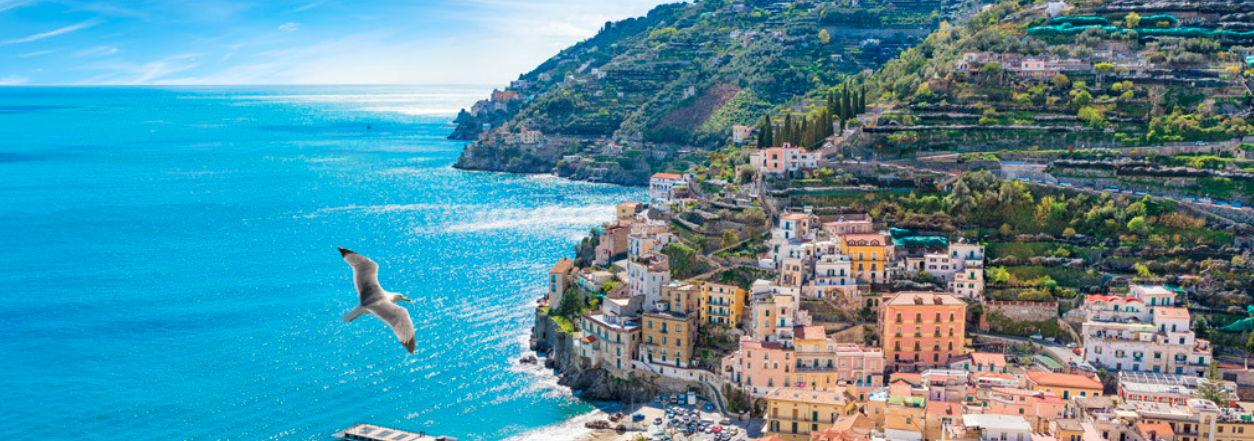Minori

Located in the centre of the Amalfi Coast, Minori, an inlet between Capo d'Orso and Conca dei Marini, is nicknamed "the narcissus of the Amalfi Coast" for the particularity of its territory and fertility of its land. It was the first to be founded by the Etruscans amongst all the towns on the coast, becoming subsequently one of the favourite places of residence by the Roman aristocracy, as testified by the discovery of the remains of an ancient patrician Villa Marittima, dating back to the 1st century AD. Today, it represents a great attraction for tourists who visit the town every year. Starting from the Middle Ages, it became part of the territory of the Amalfi Republic and its port was increasingly used as a commercial port, while some artisanal productions developed in the town, such as pasta. In fact, many were built in the centre of the country mills powered by the water of the Reginna river. Here the famous "Campania pasta" was produced: macaroni, scialatielli and the famous "ndunderi" a sort of giant dumplings prepared with flour caseata, that is spelled and curdled milk, traditional dish of Minori cuisine.
Instead, trades with the Orient favoured the introduction of lemons on the Amalfi Coast, which are still richly cultivated on terraces sloping down towards the sea nowadays, and which supply the panorama of that particular and picturesque aspect so loved by tourists from all over the world.
The cultivation of the Sfusato amalfitano lemon is particularly widespread. A beautiful bright yellow peel and rich in juice, both used in the production of typical liqueurs, such as Limoncello, and in the pastry, so renowned all over the world for desserts like Lemon Delight. Every year they attract numerous tourists in search of the flavours of the Amalfi Coast.
The Basilica of Santa Trofimena, the Church of Santa Lucia and the Church of SS Sacramento
The Basilica of Santa Trofimena, patron saint of the city, in which the remains of the saint were found by a washerwoman in 640 on the beach of Minori, according to tradition.
Religious architecture is truly highly developed and numerous churches keep many works of art in the territory of Minori. You can admire a beautiful baroque altar in the Church of Santa Lucia, with the annex Benedictine convent, both dating back to the X century. While in the Church of the Archconfraternity of the SS. Sacramento, dating back to 1526, a wooden fully functioning organ from 1700 has been preserved.
The Roman Villa
The Roman Villa of Minori of the first century AD was discovered between 1950 and 1954, buried again by the debris from the flood of 26th October 1954 and then brought to light again. This reflects the typical structure of the "Roman maritime villa" with the reception rooms located to the west of the complex and the spa to the east. Admire the frescoes, mosaics and stuccos of Triclinium Ninfeo, and the annex Antiquarium, where materials from the excavation of the villa and finds from the Roman age from other villas in the area are on display.
Borgo di Villamena and Villaggio Torre
Some villages not far from the centre of the town retain the atmosphere of times gone by. Village of Villamena is particularly pretty, as well as the ancient church of S.S. Gennaro and Giuliano, where there is a precious "altarpiece" depicting the Virgin and Saints and the processional statue of the Madonna, of the nineteenth century.
The Church of San Michele Archangel stands in the centre of the Torre Village, in the east of Minori. The foundation of the church is earlier than 1270, and it is located in an area where lemons are traditionally cultivated.
The splendid "Sentiero dei limoni" (Trail of the lemons) which reaches Maiori also starts from Torre.
Minori, City of taste
Minori is a very lively town from a cultural point of view. Summer concerts, artistic and gastronomic events take place here every year, like the Gusta Minori, melange of art, culture, shows and quality gastronomy.
Ferry service by Travelmar. For information tel. 089.872950
Parking in Minori and Maiori
There is paid street parking (marked by blue painted lines) in both Maiori and Minori along the waterfront that costs EUR 3/hour.
